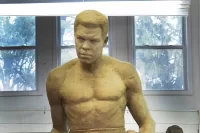Coping against the odds
If you think the current economic recession has prompted finger-pointing, check what Harry Rowe ’12, the first editor of this publication, wrote in 1936: “Higher educational institutions are on trial. They are regarded by the Right as communistic; while the Left considers them to be citadels of conservatism.”
Perhaps Rowe was still stinging from an incident a few years earlier when former Maine Gov. Percival Baxter indulged in some statewide Red-baiting. During a December 1931 speech to the Bangor Rotary Club, Baxter said that “one of our Maine colleges is more deeply involved in [teaching communism and socialism] than the others, and many of its students already have been brought under the spell of these false and un-American doctrines.”
Bates President Clifton Daggett Gray offered the first bit of payback, which Baxter apparently deemed “abusive,” according to The Bates Student. The second retort came from the Student itself. While acknowledging that some Bates students were active Socialists, the paper asked, “What of it? They are moved by a wish to alleviate the suffering of mankind.” Furthermore, the Student said, “as students confronted with a sick society…we demand the right to seek our own ideals from the raw materials of truth.”
Around that time, the Student reported on a 1931 economic conference in Augusta. There, a Maine electric company official stated that Maine colleges were teaching “babble” and that unemployment is not the “concern of society or of government.” The official’s comment prompted an immediate reaction from Bates Professor of Economics (and former debate coach) John Murray Carroll, attending the conference with nine of his students. “Fiery” is how the Student described their subsequent exchange.
The point of all this is not that Carroll called someone out. And it’s not about specific political or economic beliefs. It’s that Carroll’s students saw that ideas are capable of some heavy lifting.
A Maine native who graduated from Bates in 1909, Carroll was described as a professor who “tried to induce the student to see the significance of ideas.” It’s known that he inspired the likes of Frank Coffin ’40, LL.D. ’59, the greatly respected federal jurist who, just last fall, was honored for his contributions to legal aid for the poor here in Maine. And he likely inspired the very Student editor who likely wrote those editorials mentioned above. Valery Burati ’32, editor-in-chief in 1931–32, became a labor organizer who, in post-World War II Japan, helped to establish Sohyo, a major confederation of trade unions.
The legacy of professors like John Murray Carroll is seen on the next page, where you can read how anthropologist Elizabeth Eames’ students helped area businesses identify employment barriers facing Somali residents. And on page 28 is a story about psychologist Georgia Nigro’s work to illuminate why some boys fail to thrive in school.
And if there’s a difference between then and now, at least when it comes to the work that Bates people do in Maine, it’s that finger-pointing has been replaced by handshakes and, at times, a nice round of applause.
By H. Jay Burns, editor




